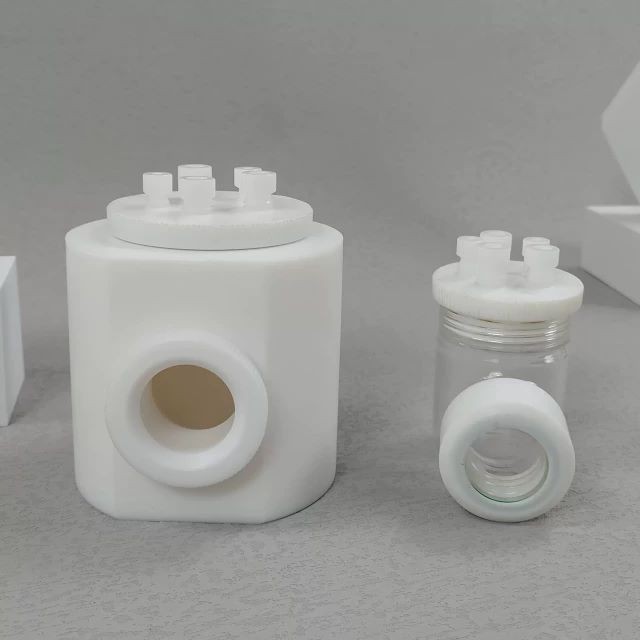
Electrochemical Consumables
Side Window Optical Electrolytic Electrochemical Cell
Item Number : ELCOS
Price varies based on specs and customizations
$199.90 / set
- Specifications
- 50ml ~ 1000ml
- Applicable temperature range
- 0 ~ 60℃
- Sealing form
- thread
Shipping:
Contact us to get shipping details Enjoy On-time Dispatch Guarantee.
Why Choose Us
Reliable PartnerEasy ordering process, quality products, and dedicated support for your business success.
A side window optical electrolytic cell is ideal for electrochemical experiments due to its corrosion resistance and complete specifications. It features good sealing and high-quality material selection, making it both safe and durable. Additionally, this type of cell can be customized to meet specific experimental needs.
Technical specifications
Quartz window electrolytic cell
| Specifications | 50ml ~ 1000ml |
| Applicable temperature range | 0 ~ 60℃ |
| Sealing form | thread |
| Material | glass + PTFE |
| Opening hole of electrolytic cell | Three electrode holes (6mm), two air holes (3mm), custom openings are available |
PTFE quartz window electrolytic cell
| Specifications | 50ml ~ 1000ml |
| Applicable temperature range | 0 ~ 60℃ |
| Sealing form | thread |
| Material | PTFE |
| Opening hole of electrolytic cell | Three electrode holes (6mm), two air holes (3mm), custom openings are available |
Detail & Parts











Operating steps
Quartz window electrolytic cell

1. The quartz window electrolytic cell is composed of a quartz light window, a sealing rubber ring, a sealing plug, a polytetrafluoroethylene cover and a cell body

2. When installing, insert the electrode and gas pipe into the electrolytic cell, and then install the sealing ring

3. Install the sealing nut of the electrode and the air hole on the electrode, squeeze the sealing ring and tighten the nut

4. Install the large sealing ring on the cell body, and completely clamp the sealing ring on the cover to ensure that the sealing ring is tightly locked

5. Installation is complete
PTFE Quartz window electrolytic cell

1. The PTFE quartz window electrolytic cell is composed of PTFE light window, sealing rubber ring, sealing plug, PTFE cover and PTFE cell body

2. When installing, insert the electrode and gas pipe into the electrolytic cell, and then install the sealing ring

3. Install the sealing nut of the electrode and the air hole on the electrode, squeeze the sealing ring and tighten the nut

4. Install the large sealing ring on the cell body, and completely clamp the sealing ring on the cover to ensure that the sealing ring is tightly locked

5. Installation is complete
Designed for You
KinTek provide deep custom made service and equipment to worldwide customers, our specialized teamwork and rich experienced engineers are capable to undertake the custom tailoring hardware and software equipment requirements, and help our customer to build up the exclusive and personalized equipment and solution!
Would you please drop your ideas to us, our engineers are ready for you now!
FAQ
What Are Optical Windows And What Are They Used For?
What Are The Different Types Of Optical Windows Available?
How Do Optical Windows Work?
What Are The Advantages Of Using Optical Windows In High-power IR Laser Applications?
Why Are CaF2 Windows Preferred In Certain Optical Applications?
What Makes MgF2 Windows Unique?
How Does Silicon Perform In Near-infrared (NIR) Applications?
What Are The Benefits Of Using High-temperature Resistant Optical Quartz Glass Sheets?
Why Are Zinc Sulfide (ZnS) Windows Preferred In Harsh Environments?
What Are The Applications Of Barium Fluoride (BaF2) Windows?
4.8
out of
5
Fantastic product. Delivery was swift and installation was a breeze. The cell is performing admirably in our lab experiments.
4.9
out of
5
This side window optical electrolytic cell is a great investment. It's durable, easy to use, and provides accurate results. Highly recommended!
4.7
out of
5
The quality of this cell is top-notch. It's well-made and has held up well in our lab. We're very satisfied with our purchase.
4.8
out of
5
This electrolytic cell is a great value for the price. It's easy to set up and use, and it's been working perfectly for our experiments.
4.9
out of
5
The performance of this cell is beyond expectations. It's precise, reliable, and has become an indispensable tool in our research.
4.7
out of
5
This cell is a must-have for any lab. It's sturdy, dependable, and delivers consistent results. We're thoroughly impressed.
4.8
out of
5
This side window optical electrolytic cell is a game-changer. It's efficient, user-friendly, and has significantly improved our lab's productivity.
4.9
out of
5
The technological advancements in this cell are remarkable. It's a testament to the innovative spirit of KINTEK SOLUTION.
4.7
out of
5
The durability of this cell is unmatched. It's been through rigorous use in our lab and shows no signs of wear or tear.
4.8
out of
5
The versatility of this cell is impressive. It can handle various experiments with ease, making it an invaluable asset to our laboratory.
4.9
out of
5
The customer service provided by KINTEK SOLUTION is exceptional. They were incredibly helpful and responsive to our inquiries.
4.7
out of
5
The delivery of this product was remarkably fast. We received it within days of placing the order, which was crucial for our ongoing research.
4.8
out of
5
The packaging of this cell was impeccable. It arrived in perfect condition, ensuring its integrity during transit.
4.9
out of
5
The value for money offered by this cell is unbeatable. It's an affordable yet high-quality piece of equipment that delivers exceptional results.
4.7
out of
5
The user manual provided with this cell is comprehensive and easy to understand. It made setup and operation a breeze.
4.8
out of
5
The compatibility of this cell with various experimental setups is a major advantage. It seamlessly integrates into our existing lab infrastructure.
4.9
out of
5
The accuracy and precision of this cell are commendable. It provides reliable and reproducible results, which is essential for our research.
4.7
out of
5
The safety features incorporated into this cell are top-notch. It ensures safe operation and minimizes the risk of accidents in the lab.
4.8
out of
5
The sleek and ergonomic design of this cell makes it a pleasure to use. It's both functional and aesthetically pleasing.
REQUEST A QUOTE
Our professional team will reply to you within one business day. Please feel free to contact us!
Related Products

Thin-Layer Spectral Electrolysis Electrochemical Cell
Discover the benefits of our thin-layer spectral electrolysis cell. Corrosion-resistant, complete specifications, and customizable for your needs.

Double-Layer Water Bath Electrolytic Electrochemical Cell
Discover the temperature-controllable electrolytic cell with a double-layer water bath, corrosion resistance, and customization options. Complete specifications included.

Double Layer Five-Port Water Bath Electrolytic Electrochemical Cell
Experience optimal performance with our Water Bath Electrolytic Cell. Our double-layer, five-port design boasts corrosion resistance and longevity. Customizable to fit your specific needs. View specs now.

Glassy Carbon Sheet RVC for Electrochemical Experiments
Discover our Glassy Carbon Sheet - RVC. Perfect for your experiments, this high-quality material will elevate your research to the next level.

Glassy Carbon Electrochemical Electrode
Upgrade your experiments with our Glassy Carbon Electrode. Safe, durable, and customizable to fit your specific needs. Discover our complete models today.

Zinc Selenide ZnSe Optical Window Glass Substrate Wafer and Lens
Zinc selenide is formed by synthesizing zinc vapor with H2Se gas, resulting in sheet-like deposits on graphite susceptors.
Related Articles

The Fragile Intersection: Mastering the Side-Window Optical Electrolytic Cell
Spectroelectrochemistry combines chemical, electrical, and optical hazards in a delicate vessel. Here is how to master the safety and precision of this complex system.

Escaping the Black Box: The Architecture of Insight in Electrochemistry
Unlock the correlation between visible phenomena and electrical data. A deep dive into the engineering and application of side-window optical electrolytic cells.

The Geometry of Truth: Why the Maintenance of Your Optical Electrolytic Cell Defines Your Data
Great data isn't just about the experiment; it's about the vessel. Learn the rigorous maintenance protocols for side-window optical electrolytic cells.

Understanding Quartz Electrolytic Cells: Applications, Mechanisms, and Advantages
Explore the detailed workings, applications, and benefits of quartz electrolytic cells in various industries. Learn how these cells facilitate precise chemical reactions and their role in high-purity metal production.

The Invisible 90%: Why Spectroelectrochemistry Succeeds Before It Begins
Experimental success isn't just about the reaction; it's about the vessel. Master the 4-step preparation protocol for optical electrolytic cells to ensure data integrity.

Understanding Electrolytic Cells and Their Role in Copper Purification and Electroplating
Electrolytic cells play a crucial role in various industrial processes, including copper purification and electroplating. These cells utilize an external power source to drive chemical reactions, resulting in the decomposition of substances. Through the process of electrolysis, an electric current is passed through a liquid or solution containing ions, causing them to break down.

Advanced Electrolytic Cell Techniques for Cutting-Edge Lab Research
Electrolytic cells are devices that utilize an electric current to induce a non-spontaneous chemical reaction.

The Silent Dialogue: Mastering Control in Electrolytic Cells
Electrolysis is a non-spontaneous act requiring precise control. Learn to interpret the interplay of voltage, current, and physical phenomena for safer lab results.

The Glass Heart of the Experiment: Mastering the Electrolytic Cell
Master the art of handling electrolytic cells. Learn the critical balance between physical fragility, chemical safety, and operational precision.

The Architecture of Precision: Why Your Electrolytic Cell Specs Matter More Than You Think
Discover the critical logic behind electrolytic cell specifications. From aperture geometry to volume trade-offs, learn how the right vessel defines experimental success.

Understanding Electrodes and Electrochemical Cells
An electrode is a point where current enters and leaves the electrolyte. It is a conductor used to make a junction with a nonmetallic part of a circuit. Electrodes can be made of materials such as gold, platinum, carbon, graphite, or metal. They serve as the surface for oxidation-reduction reactions in electrochemical cells. There are different types of electrodes, including anode and cathode.

Applications of H-Type Electrolytic Cell in Metal Extraction
H-type electrolytic cells uses an electrolyte solution to dissolve the metal ions and an electric current to separate the metal ions from the solution.